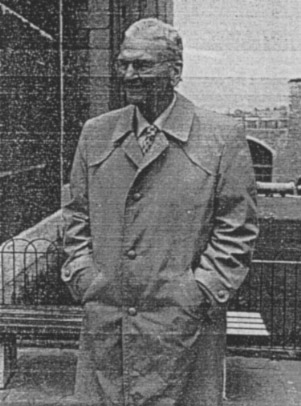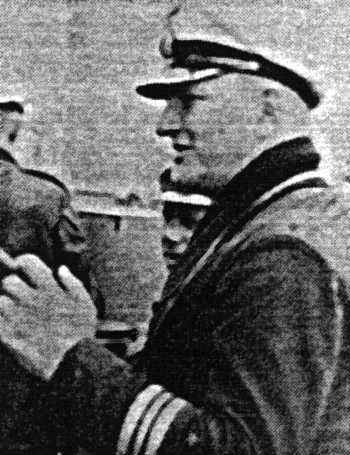
Kapitänleutnant Lott stands near the site of his old cell.
One of the last men to be imprisoned in the Tower of London made a nostalgic return to his place of captivity in September. Yeoman Warder Brian Harrison tells the story of the German U-boat captain who became...
A prisoner of the Tower
ON MONDAY September 24, shortly after the grounds of the Tower of London
had been cleared of the daily quota of tourists, a small group of Yeoman
Warders and their families hurried through the darkened, narrow, cobbled
streets to make a strange and unique rendezvous with an ex-prisoner of
the Tower.
No, they were not meeting to make contact via medium
with the ghost of some long-forgotten Tudor or Stuart victim; they were
about to meet one of the few men still living who can still make the proud
boast of being a prisoner in the Tower.
After an absence of 45 years, this ex-inmate was
able to recount to his audience, in impeccable English, vivid memories
of his incarceration.

Kapitänleutnant Werner Lott, now an impressive 77-year-old,
recalled details of his first war cruise as commander of the U-boat 35
in September to October 1939 during the course of which he 'invaded' the
neutral territorial waters of Southern Ireland in order to ensure the safety
of 28 Greek crewmen from the SS Diamantis which had been sunk by his submarine
off Land's End.
These crewmen had taken to the lifeboats before
the German torpedoes had sent their vessel to the sea-bed. Realising that
they could never survive the high seas in their flimsy craft, Captain Lott
had taken them aboard his own submarine and sailed for Ventry in County
Kerry.
Surfacing within yards of the coastline, he despatched
the ship's dinghy ferrying two Greeks at a time with one of his own crew
pulling the oars. Then, with a quick wave of farewell, the Captain gave
orders to dive, leaving the shocked Greeks and other local Irishmen gasping
at his bravado.
This simple act of humanity earned for him a severe
reprimand from Admiral Doenitz and the Second Class Iron Cross when he
returned to Germany.


The crew of U-35 after returning from their first cruise.
After a spell of leave and refitting, U-boat 35 returned
to the Battle of the Atlantic on November 18 but only eleven days later after a five-hour running battle with the Royal Navy, the submarine was so damaged by depth-charges that the Captain was forced to admit defeat and gave orders to abandon ship.
The Royal Navy lifeboats from HMS Kingston and Kashmir
scoured the area rounding up the crew until they had recovered every last one of them.
The U-boat's complement of 43 officers and men were
slowly conveyed to Scotland and then sent down to London and the Tower which, since the start of hostilities, had been cast as a Prisoner of War Collection Centre for other U-boat men and Luftwaffe pilots.
Kapitänleutnant Lott's arrogant and truculent
attitude toward his captors led to his segregation from the rest of his crew. Whereas they were given comfortable accommodation, the Captain was placed in a small cellar room with no fire and only one blanket on his iron bedstead. (The room no longer survives as the entire building called the Main Guard was destroyed by incendiaries later in the war).
In protest at this severe treatment, the prisoner
of war refused to eat until he had seen an officer and lodged his protest.
Over the next two days, his self-imposed 'hunger strike' only allowed him to partake of countless cups of scalding hot, sweet tea.
When an officer finally paid him a visit, he found
that this was not one of the Garrison Guards officers but none other than the dashing Royal Navy officer who had directed the attack on his U-boat.
To his astonishment, he learned that his visitor
was Lord Louis Mountbatten, then commanding the 'Kelly'. On finding his victim in such straits, Lord Louis soon arranged with the Camp Commandant for the prisoner to be moved into better accommodation and served a splendid meal. He later returned with an apology from the Admiralty for such harshness.
The German crew spent a few more days in the Tower
- taking great pleasure in walking in the moat of the ancient fortress and admiring the view of Tower Bridge - and then were transferred to other camps. The officers were moved to Camp Number 1 at Grizedale Hall in the Lake District and the other ranks went to Camp 127 at Glen Mill Camp, Oldham, Lancashire.
At Grizedale — often referred to a 'U-boat Hotel'
due to the excellent cuisine served there — Herr Lott was appointed to membership of the Altestenrat (Council of Elders) and was wrongly given credit for the very first escape attempt from British captivity.
Contrary to what is said of him in "The One That
Got Away", Kapitänleutnant Lott admits that he did not, and could
not, try to escape but that one of his good friends, KL Johannes Franz of the U-27, did make a rather poor attempt to get away.
At this stage of the war, whilst Germany was following
up success with success, it was not considered necessary to organise escape committees and the suchlike. After all, the men at Grizedale and Oldham were of the opinion that, if they could just sit it out a little longer, they would soon be liberated by their own forces.
However, one of the Luftwaffe pilots at Grizedale
was not content with the status quo and became anxious to get back to Germany to play a part in the final victory. He approached the Council of Elders with a daring plan for escape. Although Captain Lott could not envisage the success of the plan, her finally concurred with the other Council members
and allowed the plan to proceed.
Despite his recapture within a matter of days, the
pilot, Franz von Werra, did eventually become "The One That Got Away" after his daring jump from a Canadian train and a return to Germany by way of the United States.
Like most German prisoners of war Kapitänleutnant
Lott was detained in Canada until 1946 and, after repatriation, spent his time involved in social work and has been the director of a large rehabilitation centre for the past 10 years.
During his two day nostalgic return to London, I
was pleased to act as host to the war veteran. Having studied the history of the Tower and her prisoners for the past seven years or so, I found it most interesting to discuss with him the smaller details of this little-known aspect of Tower history and he added much data to my Tower dossier.
After his talk in the Yeoman Warders' Club, the
Korvettenkapitän — he was promoted while a prisoner — was presented with a suitable Tower of London plaque by the Yeoman Gaoler — a fitting choice in the circumstances — and returned to Germany next day, leaving behind him a group of Warders and their families who, in years to come, will delight in telling their grandchildren of the dark night when they came face-to-face with a prisoner in the Tower.
• Brian Harrison, the author of this article, would be pleased to
hear from anyone — ex-inmates or ex-guards — who might be able to provide information for the dossier he is preparing on the prisoners of the Tower.
He can be contacted at The Middle Tower, HM Tower of London, London EC3N 4AB (tel 01-481 1611).